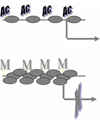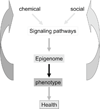Epigenetics, behaviour, and health
- PMID: 20525124
- PMCID: PMC2869339
- DOI: 10.1186/1710-1492-4-1-37
Epigenetics, behaviour, and health
Abstract
: The long-term effects of behaviour and environmental exposures, particularly during childhood, on health outcomes are well documented. Particularly thought provoking is the notion that exposures to different social environments have a long-lasting impact on human physical health. However, the mechanisms mediating the effects of the environment are still unclear. In the last decade, the main focus of attention was the genome, and interindividual genetic polymorphisms were sought after as the principal basis for susceptibility to disease. However, it is becoming clear that recent dramatic increases in the incidence of certain human pathologies, such as asthma and type 2 diabetes, cannot be explained just on the basis of a genetic drift. It is therefore extremely important to unravel the molecular links between the "environmental" exposure, which is believed to be behind this emerging incidence in certain human pathologies, and the disease's molecular mechanisms. Although it is clear that most human pathologies involve long-term changes in gene function, these might be caused by mechanisms other than changes in the deoxyribonucleic acid (DNA) sequence. The genome is programmed by the epigenome, which is composed of chromatin and a covalent modification of DNA by methylation. It is postulated here that "epigenetic" mechanisms mediate the effects of behavioural and environmental exposures early in life, as well as lifelong environmental exposures and the susceptibility to disease later in life. In contrast to genetic sequence differences, epigenetic aberrations are potentially reversible, raising the hope for interventions that will be able to reverse deleterious epigenetic programming.
Figures










Similar articles
-
Environmental epigenomics: understanding the effects of parental care on the epigenome.Essays Biochem. 2010 Sep 20;48(1):275-87. doi: 10.1042/bse0480275. Essays Biochem. 2010. PMID: 20822499 Review.
-
The epigenetics of social adversity in early life: implications for mental health outcomes.Neurobiol Dis. 2010 Jul;39(1):66-72. doi: 10.1016/j.nbd.2009.12.026. Epub 2010 Jan 4. Neurobiol Dis. 2010. PMID: 20053376 Review.
-
The social environment and the epigenome.Environ Mol Mutagen. 2008 Jan;49(1):46-60. doi: 10.1002/em.20357. Environ Mol Mutagen. 2008. PMID: 18095330 Review.
-
The dynamic epigenome and its implications in toxicology.Toxicol Sci. 2007 Nov;100(1):7-23. doi: 10.1093/toxsci/kfm177. Epub 2007 Aug 3. Toxicol Sci. 2007. PMID: 17675334 Review.
-
The early life environment and the epigenome.Biochim Biophys Acta. 2009 Sep;1790(9):878-85. doi: 10.1016/j.bbagen.2009.01.009. Epub 2009 Feb 3. Biochim Biophys Acta. 2009. PMID: 19364482 Review.
Cited by
-
The Role of Epigenomic Regulatory Pathways in the Gut-Brain Axis and Visceral Hyperalgesia.Cell Mol Neurobiol. 2022 Mar;42(2):361-376. doi: 10.1007/s10571-021-01108-0. Epub 2021 May 31. Cell Mol Neurobiol. 2022. PMID: 34057682 Free PMC article. Review.
-
Life course socioeconomic status and DNA methylation in genes related to stress reactivity and inflammation: The multi-ethnic study of atherosclerosis.Epigenetics. 2015;10(10):958-69. doi: 10.1080/15592294.2015.1085139. Epigenetics. 2015. PMID: 26295359 Free PMC article.
-
Epigenetic impact of simulated maternal grooming on estrogen receptor alpha within the developing amygdala.Brain Behav Immun. 2011 Oct;25(7):1299-304. doi: 10.1016/j.bbi.2011.02.009. Epub 2011 Feb 23. Brain Behav Immun. 2011. PMID: 21352906 Free PMC article.
-
Chronic pain: emerging evidence for the involvement of epigenetics.Neuron. 2012 Feb 9;73(3):435-44. doi: 10.1016/j.neuron.2012.01.012. Neuron. 2012. PMID: 22325197 Free PMC article. Review.
-
Diabetic Retinopathy: Mitochondria Caught in a Muddle of Homocysteine.J Clin Med. 2020 Sep 19;9(9):3019. doi: 10.3390/jcm9093019. J Clin Med. 2020. PMID: 32961662 Free PMC article. Review.
References
-
- Weidle UH, Grossmann A. Inhibition of histone deacetylases: a new strategy to target epigenetic modifications for anticancer treatment. Anticancer Res. 2000;20:1471–85. - PubMed
LinkOut - more resources
Full Text Sources

